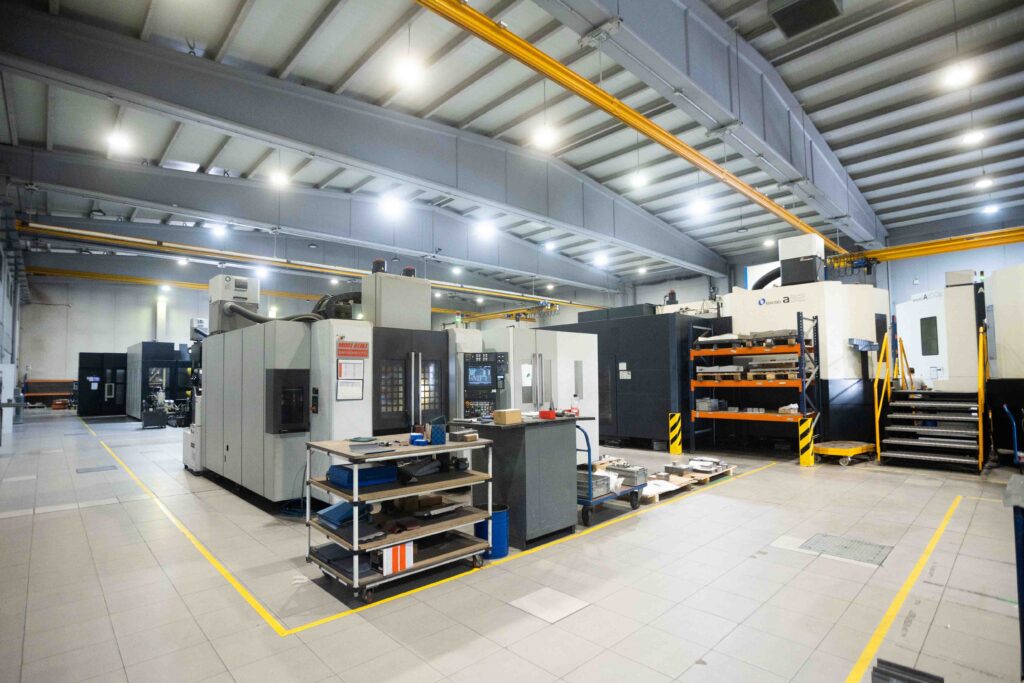Machining machinery is an essential tool in the world of industrial manufacturing. They enable operations to be carried out with a precision and efficiency that are fundamental in sectors where quality and accuracy are critical.
In this article, we will explore their role in the creation of critical aircraft components, the technologies that drive them, and how Precision Manufacturing Aerospace (PMA) uses them to raise the standards of quality and efficiency in the manufacture of metal parts for the aerospace industry.
What are the uses of machining machinery?
Machining machines are used to manufacture parts and components from various materials, mainly metals, but also plastics, composites and ceramics, among others.
These machines remove material from an initial block or blank by processes such as cutting, milling, turning or drilling, to give the desired shape and dimensions to the final product. Some of their main functions include:
- Manufacture of precision components: machining machines are essential in the production of parts with very tight tolerances and complex geometries, required in sectors such as aeronautics, automotive, medical and robotics.
- Mass production: they enable mass production of components while maintaining high consistency and quality between parts, which is crucial for large-scale industrial production.
- Prototyping and product development: machining is essential in the design and development stages of new products, where accurate prototypes are required for testing and evaluation prior to mass production.
- Repair and refurbishment: used to repair or refurbish worn or damaged parts and components, especially in industrial machinery, vehicles and equipment.
- Innovation in materials and designs: advances in machining technologies have made it possible to work with a wider range of materials and to develop innovative designs that were previously difficult or impossible to realize.
What are the applications of machining in the aerospace industry?
Machining is essential for manufacturing precise and reliable components, such as airframe structures, critical engine parts and electronic systems. Here are some of the applications in the aerospace industry.
Structural component manufacturing
One of the applications of these machines is the manufacture of critical aircraft structural components, such as fuselage parts, wings, and internal supports.
These parts must be extremely strong and lightweight, characteristics that are achieved by precision machining of advanced alloys.
Production of engine parts
Aircraft engines contain numerous machined parts, such as turbine blades, casings, and shafts. These parts must also withstand extreme temperature and pressure conditions, so the use of these high-precision machines is essential to ensure their performance and durability.
Landing systems and electronics
Landing systems, which include wheels, axles and hydraulics, also depend on these machines for their manufacture.
In addition, many housings and brackets for electronic components and navigation systems are manufactured using machining techniques, ensuring proper protection and attachment of these vital components.
What types of technology is used in machining machinery?
The incorporation of advanced technologies in the machining field has revolutionized the way industrial parts are manufactured and finished.
These innovations offer unprecedented accuracy, production efficiency and the ability to create complex designs that were previously difficult to achieve. Here are some of the most prominent types of machining:
- Vertical: ideal for operations in the vertical plane, they enable the manufacture of parts with varying complexities thanks to their precision cutting and drilling.
- Palletized horizontals: favor the automation of the machining process, especially useful for handling heavy or bulky parts, allowing complex operations without manual readjustments.
- Multi-axis machining (3, 4 and 5 axes): they offer the ability to work parts in multiple dimensions simultaneously, allowing the creation of components with complex geometries and tight tolerances.
- Electrical discharge machining (EDM): is a technique that uses electrical discharges to cut conductive materials, ideal for parts with intricate geometries with high precision and surface finish.
It is important to highlight that PMA has a wide range of state-of-the-art machining machinery. This allows to meet the challenges of the aerospace industry with maximum efficiency and precision.
Among the machines that PMA uses, there are 3-, 4- and 5-axis machining machines and models such as MORI-SEIKI or DECKEL MAHO among others. In addition, it also includes other technologies such as EDM, Lapping or Laser welding.
For more information about our advanced technological capabilities or to receive personalized assistance on your specific project, please do not hesitate to contact us. We are ready to offer you tailor-made solutions that perfectly align with your requirements.

